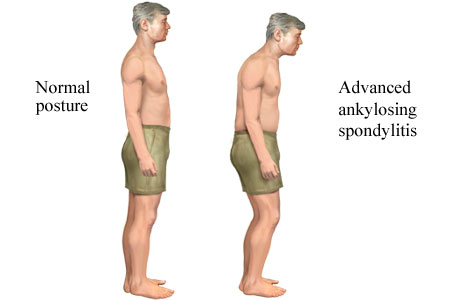General Health Tips & News
Living with Ankylosing Spondylitis
By A.S. (staff writer) , published on August 19, 2023

Medicine Telehealth Health
Ankylosing spondylitis is a form of arthritis that triggers inflammation in the joints and ligaments of the spine, and sometimes affects peripheral joints like the knees, ankles, and hips. The inflammation in the spine's joints and tissues can lead to stiffness, and in severe cases, it may cause the bones in the spine (vertebrae) to fuse together, resulting in a rigid and inflexible spine.
It falls under the category of autoimmune diseases, where the body's immune system mistakenly attacks its own tissues. AS is characterized by inflammation, pain, and stiffness in the affected joints, and if left unmanaged, it can lead to fusion of the spine, resulting in a hunched posture and reduced mobility. This article aims to provide an overview of Ankylosing Spondylitis, its causes, symptoms, diagnosis, and management.
Causes of Ankylosing Spondylitis
The exact cause of Ankylosing Spondylitis is still not fully understood. Genetics play a significant role, as individuals with a specific gene called HLA-B27 are at a higher risk of developing the condition. However, not everyone with this gene will develop AS, indicating that other environmental and genetic factors might contribute to its development. Some possible risk factors include a family history of AS, gender (males are more susceptible), and certain bacterial infections that may trigger the immune response leading to the condition.
Symptoms of Ankylosing Spondylitis
Symptoms of ankylosing spondylitis can vary, with some individuals experiencing intermittent pain, while others suffer from chronic and severe pain. Symptoms may worsen during flare-ups and improve during periods of remission. The disease's impact can extend to other parts of the body, leading to pain, stiffness, and inflammation in other joints like the ribs, shoulders, knees, or feet. In some cases, it may affect the joints connecting the ribs, causing difficulty in taking deep breaths. Eye inflammation (uveitis), fatigue, loss of appetite, skin rashes (psoriasis), and abdominal pain and loose bowel movements are other potential symptoms.
Diagnosis of AS
Diagnosing AS can be challenging, as its symptoms might mimic other conditions. A comprehensive evaluation by a rheumatologist is crucial to determine an accurate diagnosis. The diagnostic process may include medical history, physical examination, blood tests to check for the presence of the HLA-B27 gene and markers of inflammation, and imaging scans like X-rays and MRI to detect inflammation and joint damage.
Treatment
Treatment for ankylosing spondylitis focuses on slowing down the progression of the condition and managing pain and stiffness to enable patients to lead normal life. Besides medical treatments, exercise, and maintaining good posture are equally important for keeping the spine mobile and improving quality of life.
Drug Treatments:
-
Painkillers and NSAIDs: Paracetamol and NSAIDs like ibuprofen are typically the initial treatment for ankylosing spondylitis to alleviate pain and reduce inflammation.
-
Disease-modifying anti-rheumatic drugs (DMARDs): Drugs such as sulfasalazine and methotrexate can treat arthritis in the arms and legs and reduce overall inflammation, which helps prevent joint damage. These are long-term treatments that require regular check-ups and blood tests to monitor their effectiveness.
-
Biological Therapies: Newer treatments, known as biological therapies, like anti-TNF drugs (etanercept, adalimumab, certolizumab pegol, golimumab) and IL-17 inhibitors (e.g., secukinumab) have a more targeted approach to reduce inflammation. These are prescribed if symptoms cannot be controlled with NSAIDs and physiotherapy. They are administered as injections and require regular monitoring and assessment of treatment effectiveness.
Steroids:
-
Steroids are used as a short-term treatment during flare-ups. They can be given as injections into swollen joints or muscles. Prednisolone tablets may also be prescribed but should be used cautiously due to potential side effects if used for extended periods.
Physical Therapies:
-
Physiotherapy: An essential part of the treatment, physiotherapy involves tailored exercises to improve muscle strength and maintain mobility in the spine and other joints. Back and neck exercises are particularly important to prevent stiffness.
-
Hydrotherapy: Also known as aquatic therapy, involves specific exercises carried out in a warm-water pool, benefiting the spine, hips, and shoulders. Many find this therapy helpful and continue their exercises at local swimming pools or with support groups like the National Ankylosing Spondylitis Society (NASS).
Surgery:
-
Most individuals with ankylosing spondylitis do not require surgery. However, some may need a hip or knee replacement if these joints are severely affected, which can relieve pain and improve mobility.
-
In rare cases where the spine is severely bent, surgery might be considered. Such decisions should be made in consultation with an experienced spinal surgeon and a rheumatologist.
Overall, a combination of these treatment approaches can effectively manage ankylosing spondylitis, slow its progression, reduce pain, and improve mobility. Regular check-ups and ongoing communication with healthcare providers are essential to monitor the condition's progression and adjust treatment plans as needed.
Living with Ankylosing Spondylitis
Living with Ankylosing Spondylitis can be challenging, but with proper management and support, individuals can lead fulfilling lives. Engaging in low-impact exercises, such as swimming or yoga, can improve physical and mental well-being. Regular medical follow-ups and a proactive approach to lifestyle modifications are essential for those living with AS. By working closely with healthcare professionals and adopting a healthy lifestyle, individuals with AS can lead active and productive lives while effectively managing the condition's impact on their daily activities.
References
-
Arthritis Foundation. Axial Spondylarthritis. (https://www.arthritis.org/diseases/ankylosing-spondylitis) Accessed 7/22/2020.
-
National Institute of Arthritis and Musculoskeletal and Skin Diseases. Ankylosing Spondylitis. (https://www.niams.nih.gov/health-topics/ankylosing-spondylitis) Accessed 7/22/2020.
-
Spondylitis Association of America. Overview of Ankylosing Spondylitis. (https://spondylitis.org/about-spondylitis/types-of-spondylitis/ankylosing-spondylitis/) Accessed 7/22/2020.
Find articles related to: Medicine Telehealth Health
More articles about General Health Tips & News
Back to the Health Tips Index




